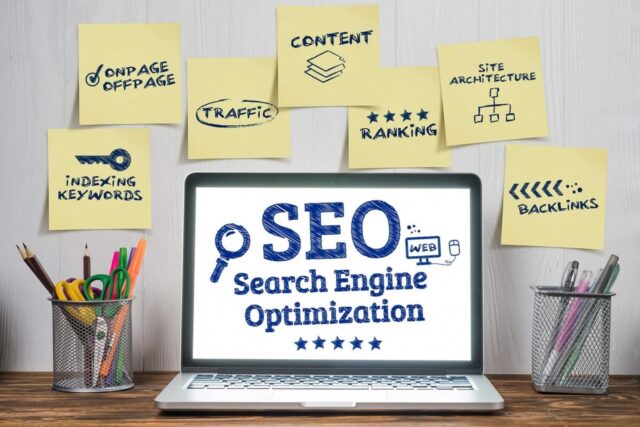How To Conduct Website SEO Audit In 9 Easy Steps?

If you’re looking to maximize your website’s search engine optimization (SEO) potential, then you should consider conducting a website audit. While it may seem intimidating at first, an SEO audit is quite simple and can be done in as little as 9 easy steps. In this essential guide, we’ll walk you through each step of the audit process and provide helpful tips to ensure you get the most out of your audit. By the end, you’ll be well on your way to boosting your website’s SEO potential!
Optimize Your Website’s Performance and Boost Your SEO Ranking with These 9 Easy Steps
1. Familiarize yourself with Google Analytics

Before you begin your SEO audit, it’s important to get familiar with Google Analytics. This free tool provides valuable insights into your website’s traffic and performance. By tracking user behavior, you can learn which pages are popular and where visitors are coming from. You can also monitor your website’s bounce rate, session duration, and conversion rates. In addition, Google Analytics allows you to create custom reports and dashboards to keep track of the metrics that matter most to your business. Once you’ve set up Google Analytics on your website, you’ll be better equipped to make informed decisions about your SEO strategy.
2. Check your website’s loading speed
A slow-loading website can be a major turnoff for users, which in turn can negatively affect your SEO. Also a slow loading website can negatively impact user experience, which in turn can result in a higher bounce rate and lower search engine rankings. To check your website’s loading speed, you can use free tools such as Google PageSpeed Insights or GTmetrix. These tools can provide you with a detailed report on your website’s loading speed, along with recommendations on how to improve it.Use Google’s PageSpeed Insights tool to check your website’s loading speed and get suggestions for improvement. You should also consider compressing your website’s images, minimizing HTTP requests, and enabling browser caching to speed up load times. Keep in mind that different devices and browsers may have varying loading times, so it’s important to test your website on multiple platforms to get an accurate picture of its speed. Don’t underestimate the impact of website speed on user experience and SEO, and make improvements wherever necessary.
3. Optimize your website’s title tags and meta descriptions

Title tags and meta descriptions play a vital role in attracting traffic to your website. They serve as the first impression of your website on search engine result pages. Thus, optimizing them is essential to increase click-through rates. Title tags and meta descriptions are important elements of on-page SEO. They provide search engines with a brief description of the content on your website, which can help improve your website’s visibility in search engine results. To optimize your website’s title tags and meta descriptions, you should ensure that they accurately reflect the content on each page of your website and contain relevant keywords. This can help search engines understand what your website is about and improve your ranking in SERPs. To optimize your title tags, ensure they are descriptive, relevant, and contain keywords. Keep them under 60 characters and avoid duplicates. Similarly, optimize your meta descriptions by creating concise summaries of your page’s content. Ensure they are unique, persuasive, and relevant to your content. Keep them under 155 characters. Using compelling titles and meta descriptions can make your website stand out and attract more clicks from potential visitors.
4. Check for broken links
Broken links, or links that lead to non-existent pages, can negatively impact user experience and harm your website’s ranking in SERPs. To check for broken links on your website, you can use tools such as Screaming Frog or Google Search Console. These tools can crawl your website and identify any broken links, which you can then fix or remove. It is important to regularly check for broken links, as they can occur due to changes in your website’s structure or external links that are no longer valid.
A broken link is a hyperlink that directs users to a page that no longer exists or is unavailable. These links can negatively impact your website’s search engine optimization, so it’s important to regularly check for them. One of the easiest ways to check for broken links is to use a tool such as Google Analytics or a free online broken link checker. Simply input your website’s URL, and the tool will crawl through your pages and identify any broken links.
Once you have a list of broken links, you can take steps to fix them. For internal broken links, update the hyperlink with the correct URL. For external broken links, consider removing the hyperlink altogether or reaching out to the website owner and requesting a correction. By fixing broken links, you’ll not only improve your website’s SEO but also create a better user experience for your visitors. So, don’t neglect this important aspect of your website maintenance.
5. Analyze your website’s backlinks

Backlinks are one of the most important factors in SEO as they signal to search engines that other websites consider your content valuable enough to link to. Therefore, it’s important to analyze your website’s backlinks regularly. Start by using a backlink checker tool, such as Ahrefs or SEMrush, to get a list of all the websites that link to your website. You can also check the quality and authority of those links to ensure that they’re coming from reputable sources. Keep in mind that not all backlinks are equal, and some may hurt your website’s rankings if they come from spammy or low-quality websites.
Once you have a list of backlinks, check if any of them are broken or no longer exist. You can also reach out to websites that link to your website and request that they update the link to a more relevant page or resource. Analyzing your website’s backlinks is crucial to maintaining a healthy SEO strategy. It allows you to identify potential issues and opportunities for improvement to ensure that your website is being seen by the right people.
6. See how well your website is being shared on social media
In today’s digital age, social media is a crucial component of any effective SEO strategy. Not only can social media be used to build brand awareness, but it also serves as a powerful tool for driving traffic to your website. When conducting an SEO audit, it is essential to examine how well your website is being shared on social media platforms.
First, take a look at your website’s social media buttons. Are they easily accessible? Do they encourage visitors to share your content? Next, examine your social media profiles. Do they have strong descriptions, eye-catching visuals, and regular posts? Ensure that your social media presence is engaging and active. Also, utilize tools like BuzzSumo to see how your content is performing on social media. This platform allows you to see which pages are being shared the most, and by whom. This information can help you determine which topics resonate with your audience and identify potential areas for improvement.
7. Check if your website is mobile-friendly
With mobile devices becoming more prevalent in today’s world, it is essential to ensure your website is mobile-friendly. A mobile-friendly website is not only convenient for users but also plays a crucial role in search engine optimization. Google favors mobile-responsive websites and ranks them higher in search results.
To check if your website is mobile-friendly, you can use Google’s Mobile-Friendly Test tool. This tool checks your website’s responsiveness on various mobile devices and provides you with a detailed report on areas that need improvement. Additionally, you can also check the overall user experience of your website on a mobile device to identify any other issues that need fixing. Don’t miss out on potential customers due to a non-responsive website – make sure your site is mobile-friendly!
8. Identify your website’s most popular pages
Knowing which pages on your website are the most popular is essential in optimizing your SEO strategy. You can use Google Analytics to determine which pages are receiving the most traffic, how long visitors are spending on those pages, and which keywords are bringing them there. Once you’ve identified your website’s top pages, you can use that information to refine your SEO strategy. You may want to consider adding more content to those pages, improving the meta descriptions or title tags, or adding more internal links to direct traffic to those pages. By paying attention to your website’s most popular pages, you can better target your SEO efforts and improve your overall website performance.
9. Use Google Search Console to find potential SEO issues
Google Search Console is a powerful tool that can help you identify any potential SEO issues on your website. Use it to track your website’s search traffic, see which keywords people are using to find your website, and check if there are any crawl errors or security issues that need to be fixed. Additionally, you can submit sitemaps and individual URLs for crawling and indexation, and receive alerts when there are any critical issues detected. Use this tool regularly to keep your website’s SEO performance in check.
What Are The 7 Effective Tips to Improve Your Content’s Visibility on Search Engines?
In today’s digital age, search engine optimization (SEO) is an essential part of any successful digital marketing strategy. It’s about optimizing your website and its content to rank higher in search engine results pages (SERPs), which can generate more traffic and lead to the site. your. One of the most important aspects of SEO is optimizing your website content to improve its visibility on search engines.Here’s the seven effective tips to improve the visibility of your content on search engines.
1.Keyword research:
The first step in optimizing your content for SEO is to do thorough keyword research. Keyword research involves identifying relevant keywords and phrases that your target audience is searching for. You can use tools like Google Keyword Planner and SEMrush to find related keywords and phrases. Once you’ve identified your keywords, use them in your titles, meta descriptions, title tags, and content. However, avoid keyword stuffing, as it can affect your site’s rankings.
2. Title tag:
Title tags are HTML tags that describe your web page content. They are displayed as clickable titles in search engine results pages. Therefore, it is essential to use descriptive and keyword-rich title tags to describe your website content. Make sure your title tag is less than 60 characters to avoid truncation in search engine results.
3. Meta Description:
Meta descriptions are HTML tags that give users a brief overview of your site’s content. They are displayed under the title tag in search engine results pages. Therefore, it is important to write concise and engaging meta descriptions to encourage users to click through to your website. Keep your meta description under 155 characters.
4. Header tag:
Header tags (H1, H2, H3) are HTML tags used to divide your content into sections and make it easier to read. They also help search engines understand the structure of your content. Therefore, it is essential to use title tags in your content. Make sure your title tags contain relevant keywords to improve the visibility of your content on search engines.
5.Content optimization:
Optimizing the readability and relevance of your content is crucial to improving its visibility on search engines. Use short sentences, bullet points, and subheadings to break up your content and make it easier to read. Use relevant keywords in your content, but avoid keyword stuffing as this can affect your website rankings. Use images, videos, and other media to make your content more engaging and shareable.
6. Internal linking:
Internal linking is the process of internally linking your web pages to provide users with a seamless browsing experience. It also helps search engines understand your site structure. Therefore, it is important to internally link your web pages. Make sure your internal links are relevant and use descriptive link text. However, avoid excessive linking as it can affect your site’s rankings.
7. Mobile optimization:
Optimizing for mobile is making sure your website is optimized for mobile devices. As more and more users access the Internet through their mobile phones, mobile optimization has become an important aspect of SEO. Use responsive design to ensure your website is accessible on all devices. Optimize images for faster loading speed, as slow loading websites can affect your site’s ranking.
CONCLUSION
Optimizing your content for SEO is key to improving its visibility on search engines and driving more organic traffic to your website. By doing thorough keyword research, using descriptive and keyword-rich meta descriptions and title tags, using title tags, and optimizing your content for readability and relevance, By linking By internally linking your web pages and optimizing your site for mobile devices, you can improve the visibility of your content on search engines. These tips can help you improve your website rankings, drive more traffic and leads to your site, and ultimately grow your business.








5 thoughts on “How To Conduct Website SEO Audit In 9 Easy Steps?”
Comments are closed.